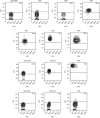Functional interleukin-33 receptors are expressed in early progenitor stages of allergy-related granulocytes
- PMID: 27568595
- PMCID: PMC5341505
- DOI: 10.1111/imm.12667
Functional interleukin-33 receptors are expressed in early progenitor stages of allergy-related granulocytes
Abstract
Interleukin-33 (IL-33) induces T helper type 2 (Th2) cytokine production and eosinophilia independently of acquired immunity, leading to innate immunity-mediated allergic inflammation. Allergy-related innate myeloid cells such as eosinophils, basophils and mast cells express the IL-33 receptor (IL-33R), but it is still unknown how IL-33 regulates allergic inflammation involving these cells and their progenitors. Here, we revealed that the functional IL-33R was expressed on eosinophil progenitors (EoPs), basophil progenitors (BaPs) and mast cell progenitors (MCPs). In the presence of IL-33, these progenitors did not expand, but produced a high amount of Th2 and pro-inflammatory cytokines such as IL-9, IL-13, IL-1β and IL-6. The amount of cytokines produced by these progenitors was greater than that by mature cells. In vivo, IL-33 stimulated the expansion of EoPs, but it was dependent upon the elevated serum IL-5 that is presumably derived from type 2 innate lymphoid cells that express functional IL-33R. These data collectively suggest that EoPs, BaPs and MCPs are not only the sources of allergy-related granulocytes, but can also be sources of allergy-related cytokines in IL-33-induced inflammation. Because such progenitors can differentiate into mature granulocytes at the site of inflammation, they are potential therapeutic targets in IL-33-related allergic diseases.
Keywords: basophils; cytokines; eosinophils; haematopoiesis; mast cells.
© 2016 John Wiley & Sons Ltd.
Figures






References
-
- Liew FY, Pitman NI, McInnes IB. Disease‐associated functions of IL‐33: the new kid in the IL‐1 family. Nat Rev Immunol 2010; 10:103–10. - PubMed
-
- Haenuki Y, Matsushita K, Futatsugi‐Yumikura S, Ishii KJ, Kawagoe T, Imoto Y et al A critical role of IL‐33 in experimental allergic rhinitis. J Allergy Clin Immunol 2012; 130:184–94. - PubMed
-
- Chu DK, Llop‐Guevara A, Walker TD, Flader K, Goncharova S, Boudreau JE et al IL‐33, but not thymic stromal lymphopoietin or IL‐25, is central to mite and peanut allergic sensitization. J Allergy Clin Immunol 2013; 131:187–200. - PubMed
-
- Préfontaine D, Lajoie‐Kadoch S, Foley S, Audusseau S, Olivenstein R, Halayko AJ et al Increased expression of IL‐33 in severe asthma: evidence of expression by airway smooth muscle cells. J Immunol 2009; 183:5094–103. - PubMed
MeSH terms
Substances
Associated data
- Actions
LinkOut - more resources
Full Text Sources
Other Literature Sources
Medical
Molecular Biology Databases

